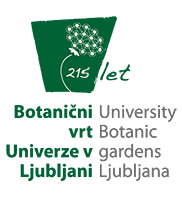STANDARD OFFER:
1. General tour of Botanic Garden in different seasons
2. Structure of the plants, biological communities and ecology
(1) Plants, their use and importance for humans
(2) Medicinal plants
(3) Meadow and meadow plants
(4) Plants and animals in the puddle, bog plants in the Botanic Garden
(5) Tropical glasshouse – plants of tropical and subtropical sites and adjustments to their environment
(6) Ecology, ecosystems and ecological conditions of plants
(7) Forest and woody plants
(8) How to present plants to preschool children?
3. Systematics
(1) Systematics
(2) How to determine plants?
4. Magnifiers
(1) Seeds
(2) Plant organs
(3) Systematics
5. Excursion to Ljubljana Moors
- General tour of Botanic Garden in different seasons
We take a look at all parts of the Botanic Garden: Arboretum, Rockery, Tropical glasshouse, Wetlands, Plant system... and learn about tipical plants, their characteristics, habitats... The Botanic Garden is more than just an interesting park. In the very center of Ljubljana, you can observe the endagered, rare or nearly extinct plants, learn about species diversity – biodiversity of Slovenia and the world, you see animals who have found refuge in similar conditions as in nature. Every season shows a different picture of the plant kingdom.
Performed throught the year. - Structure of the plants, biological communities and ecology
On live plants, students observe how mono- and dicotyledons, gymnosperm and angiosperms differ. Each biological community is characterized by unique plants. On meadow and in plant system, we learn about meadow plants in the puddle and in pools we observe aquatic, marsh and bog plants and aquatic animals. In rockery we get to know mountain and karst plants, including many endangered and protected. In Arboretum we learn about native and exotic woody species, ecology of plants in the undergrowth, vines, importance of the forest… The Tropical glasshouse offers the possibility of learning about the tropical and subtropical ecosystems, the local climate, vegetation, interspecies relationships.
(1) Plants, their use and importance for humans
(2) Medicinal plants (performed from May to October)
(3) Meadow and meadow plants (performed from May to September)
(4) Plants and animals in the puddle, bog plants in the Botanic Garden (performed from May to September)
(5) Tropical glasshouse – plants of tropical and subtropical sites and adjustments to their environment (performed throught the year)
(6) Ecology, ecosystems and ecological conditions of plants
(7) Forest and woody plants (performed from April to November)
(8) How to present plants to preschool children?
* Autumn, Carnivorous plants and Poisonous plants
* Trees during Winter, Hearlds of Spring and Fruits
* Meadow, Puddle and Poisonous plants - Systematics
Systematics is the part of biology, that is in school benches at least interesting, but if you go into the wild, it becomes a real adventure. In Botanic Garden students observe live plants, they get a sense of how big it really is a Linné's contribution to the understanding of the plant kingdom. We walk among the flower beds in the plant system and learn about the diversity of plant species within the same family. Using the Identifying keys, students can be introduced to determining plants and arranging them into the plant system. It is performed in combination with general tour, learning about the differences between monocotyledonous and dicotyledonous plants, gymnosperms and angiosperms or determining plants with the Identifying keys.
(1) Systematics
(2) How to determine a plants? (using advanced Idetifying keys) - Magnifiers
As a suplement to some lessons, offered in Botanic Garden, the use of monoocular magnifiers in combination with the software Motic Educator, is now also available. With the help of magnifiers, students can get to know with a miniature world of plants that can not be seen by the naked eye; they can observe the inside of the blossom, parts of the blossom, and other plant organs. They can also admire the diversity in form of seeds and other concealed structures in different parts of a plant. Motic Educator program allows the images to be simply captured and edited.
(1) Seeds
(2) Plant organs
(3) Systematics - Excursion to Ljubljana Moors
We briefly present the Botanic Garden, where we particulary focus on bog plants, that have become practically extincted in the Ljubljana Moors. On the Moors we visite the remains of peat bog Mali Plac, where the marshes and bog vegetation can be seen, and peatlands of Jurč, where we can see the remains of peat and observe the overgrowth. If you decide for an excursion at a time when Snakeshead Lili is in ful bloom, we also visite the wet meadows in villlage Bevke and observe this protected beauty in its natural environment.
Performed from April to September.
(1) Excursion to Ljubljana Moors: visitation of the remains of a peat bog Mali Plac with its typical vegetation and peatlands of Jurč
(2) Bog plants in the Botanic Garden and the excursion to Ljubljana Moors
We recommend 3–hour excursion. 4–hour and 5-hour excursion are suitable in combination with the guided tour of the Botanic Garden.







